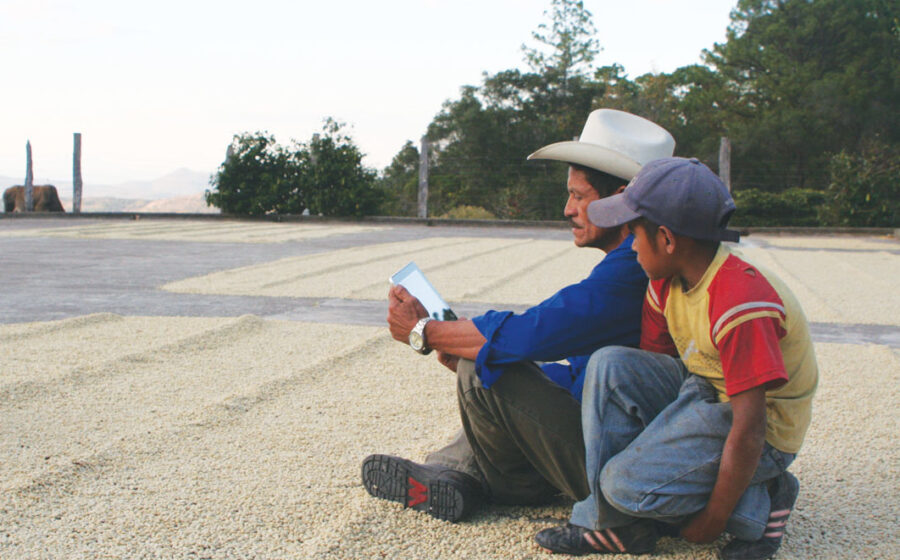[W]e all know that technologies like social media platforms, new e-commerce tools, and smartphone apps have transformed virtually every industry. Interactions between businesses and their customers have changed, from how people shop and purchase, to the ease of accessing information about products, companies, and business practices at the touch of a button. The popularity of direct-trade business models in the specialty coffee industry is made possible by technological advances that brought a new trait to the coffee supply chain: transparency.
The most obvious new abilities enabled by technology are for coffee drinkers. A coffee connoisseur can now, if she’s interested, learn about the coffee and the farmer who grew that coffee not just from the package or menu board or even the roastery’s website, but from the farmer’s own Facebook profile and website. Because this type of technology-driven transparency allows customers to easily find accurate and real-time information about companies’ supply chains, they expect this information more and more. If a roaster is promoting its direct trade relationships, his curious customers will expect, at a minimum, to be provided photos of coffee farms and farm visits, which can easily be posted to social media sites in real-time while still on an origin trip.
Thanks to the ever-expanding digital grid, smallholding coffee farmers who live in places that can still take more than eight hours to reach by car can nevertheless be active on Facebook.
Visitors to origin aren’t the only beneficiaries of social media connections. Thanks to the ever-expanding digital grid, smallholding coffee farmers who live in places that can still take more than eight hours to reach by car can nevertheless be active on Facebook, looking over photos of coffee bags featuring their own faces and farm names. The information better be correct! Though language barriers are prohibitive, consumers can and do follow and communicate directly with farmers online, completing the direct-trade circle in a way not possible just a few years ago.
But the impact of our expanding online capabilities doesn’t stop at things as obvious as being able to communicate directly with coffee farmers on social media. Even more revolutionary, really, is how e-commerce tools can change the way coffee importers and direct-trade roasters buy coffee.
For example, the entire Cup of Excellence program is made feasible by the ability of buyers from around the world to bid on COE coffees in real-time on an online auction site. The major commodity traders still have economies of scale in logistics, but their economies of scale in accessing information about coffee farms and farmers are greatly reduced by the flourishing of social media, such as the many active coffee producer groups on LinkedIn and other ever-improving e-commerce tools. These allow smaller and specialty coffee sellers to offer as much, if not more, detailed and low-cost producer information to buyers. This increases chain transparency and the ability of small traders to establish credibility and build brand identities.
E-commerce changes how businesses can sell, as well as how they can buy. Roasters can use social media and e-commerce to educate customers and promote and sell their coffees. They can do this in ways that are cheaper, more flexible, and better suited to diverse coffee offerings than traditional marketing and distribution channels.
By nature, the coffees offered by a roaster using a direct-trade business model are likely to be more seasonal and dynamic than traditionally sourced coffees. The roaster may run out of last year’s coffee from a direct trade partner before he receives the new crop; one farmer’s coffee may taste different than her harvest from last year; and the roaster may change offerings year by year depending on the quality of coffees from particular regions or farms.
For a roastery that uses its website as its primary storefront, though, the costs of updating rotating roasts, and promoting new farm offerings on a blog or Facebook page are minimal. This type of e-commerce-powered business model makes online-only, rotating-coffee business models possible and ignited the boom of online companies in the last three years or so.
Some areas that technology hasn’t gotten around to transforming, though, are production and supply chain costs. E-commerce makes it easy to sell many differentiated coffees from specific farmers to customers all around the world, and social media makes it easy to market and promote them, as well as easier to find new direct-trade partners in origin countries. But neither of these tools make it cheaper to visit origin countries, or to fill and ship your own containers overseas. Ideally, direct-trade coffee roasters will successfully market their coffees, and grow their businesses to the point where they can afford the extra cost of direct trade. While a roaster is still small, however, neither technology nor transparency absorb the extra cost of direct trade over buying coffee from commodity markets.
Transparency also doesn’t help much with addressing the systemic production problems in coffee producing communities, including limited physical infrastructure and weak agronomic training and extension. However, there is room for innovation in these areas: for example, multimedia agronomic training apps or shipping platforms that allow for easier, cheaper consolidation of shipping containers. When amazing technological advances are directed toward the initial parts of the supply chain the way they are to the marketing end, that will spark truly revolutionary changes in the coffee industry.
—Christina Valverde is the director of marketing and strategy at Invalsa.
—Photo courtesy of Sustainable Harvest.
















